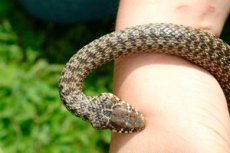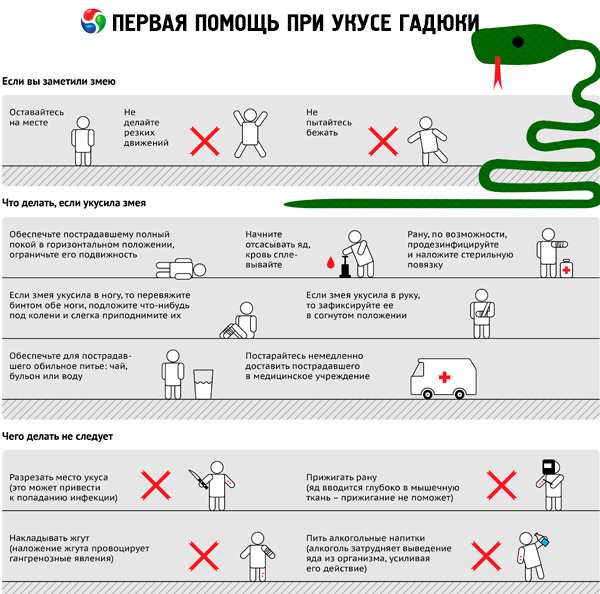Medical expert of the article
New publications
Common viper bite: what to do, how to avoid?
Last reviewed: 05.07.2025

All iLive content is medically reviewed or fact checked to ensure as much factual accuracy as possible.
We have strict sourcing guidelines and only link to reputable media sites, academic research institutions and, whenever possible, medically peer reviewed studies. Note that the numbers in parentheses ([1], [2], etc.) are clickable links to these studies.
If you feel that any of our content is inaccurate, out-of-date, or otherwise questionable, please select it and press Ctrl + Enter.

The common adder is one of those snakes that bite only in extreme cases, when protection and self-defense are necessary. The snake never attacks first. Therefore, in order to avoid a bite, it is necessary to be extremely careful and ensure that under no circumstances do you disturb the snake. You need to be especially careful in the morning, at dawn, since at this time snakes usually come out into the sun to warm themselves. Snakes often live in peat litter, in loosened soil, under damp leaves in the forest, in open clearings. Often snakes hide in grass and thickets. You need to be extremely careful when passing through thickets.
The risk of being bitten by a viper increases in the spring, especially in late April and early May. During this period, snakes usually become active, they have offspring, and they wake up after hibernation. The sun's rays warm the earth, and snakes quite often crawl out into the open, and like to sit on rocks. You should also be careful when visiting caves, forest gorges, and burrows. You can run into a viper in a haystack, under abandoned building materials, in old, loose buildings. Reservoirs are also dangerous, since snakes can swim. Reservoirs with a lot of thickets and reeds are especially dangerous.
The viper lives mainly in the central part of Russia.
It is quite easy to recognize a snake by its appearance: it has a zigzag shape and a gray color. There is also a dark stripe along the snake's body. Most often, it has torn, crooked edges, but less often there is a smooth edge. Mostly, vipers are gray, but sometimes they are black.
Epidemiology
According to statistics, if first aid is provided correctly, the therapy has a positive outcome. If first aid is not provided, a fatal outcome will occur. If first aid is not provided, only 13% of people managed to survive within 2-3 hours. If first aid is provided in a timely manner, there is a chance to recover quite quickly, and the bite can pass without serious consequences.
Causes of a viper's bite
Vipers are cold-blooded, so they are active during the day. They mostly come out on warm, sunny days. At night, they are active only if the air temperature is quite high. At night, snakes can crawl to a fire.
It is important to know that a snake always attacks only after a preliminary warning: it usually hisses, takes an arched pose - a pose of threat, intimidation, then makes several improvised lunges forward. If you do not get out of the way of such a snake, it will be forced to lunge. You should not touch the snake, approach it, and also do not make sudden movements, as this can frighten the snake and force it to attack in self-defense.
Symptoms of a viper's bite
When bitten, a person usually feels severe pain. This is due to the fact that the snake bites the skin and also injects poison into the wound site, which then spreads throughout the body, the pain constantly progresses, increases. At first, a local reaction develops, which is accompanied by itching, burning, swelling, irritation. The skin at the site of the bite turns red. After some time has passed, a systemic reaction develops, that is, inflammation and redness spreads, the toxin from the snake bite penetrates deep into the body.
It is necessary to take into account that the poison shows high tropism to the nervous tissue, therefore it is affected first. In this regard, the most dangerous is a bite in the head and neck area. The least dangerous is a bite in the legs and arms. But this does not mean that first aid should not be provided. On the contrary, it is necessary to suck out the poison as quickly as possible, neutralize it, and carry out antitoxic quality.
Cytokines contained in the immune system cause an inflammatory process to develop in the blood, and the blood coagulation system is disrupted. The process is accompanied by severe pain. If first aid and subsequent treatment are not provided, the swelling will only increase. The most severe stage is the necrosis of the affected tissue.
Intoxication is usually accompanied by a strong intoxication process, during which an inflammatory process develops, signs of typical poisoning appear: nausea, vomiting, diarrhea. The process is also accompanied by shortness of breath, increased heart rate.
Treatment of a viper's bite
The essence of first aid for a snake bite is to remove the poison from the body. In the first hours after the bite, you need to suck out the poison as quickly as possible. This is especially important when hiking, if there is no medical facility nearby. People often ask the question: is it possible to get poisoned by the poison that gets into the mouth when sucking. Here you can immediately reassure the person providing first aid: the poison is not dangerous if it gets into the mouth, since it causes poisoning only if it gets into the blood. The distinctive feature is damage to the blood clotting system.
If a snake bites, first of all, emergency assistance is provided on the spot. Then, the victim must be taken to the hospital as quickly as possible. Statistics convincingly show that in most cases, it is not so much the bite itself that is dangerous, as the wrong actions after the bite.

So, the order of actions is approximately as follows:
- The poison must be sucked out through the hole left after the bite.
- Call an ambulance immediately.
- If you have to transport the victim, it is necessary that the bitten part of the body be immobilized. In no case should the injured part of the body be moved in any way, since movement will promote rapid absorption and will also help the poison spread faster throughout the body.
- If you are prone to allergic reactions, if inflammation or severe redness develops, you should take an antiallergic or antihistamine. Antiallergic medications should be taken with you on hikes.
- You need to drink as much liquid as possible, since drinking helps to quickly remove toxins from the body, reduces intoxication and inflammatory processes. You need to drink a lot, but in small portions. You need to drink at least 3 liters of liquid per day. It is best to drink clean drinking water, but juice will do as well. Apple juice, citrus juice, and pomegranate juice have proven themselves well.
Allow the doctor to provide the necessary assistance independently. Do not self-medicate, as it can only harm the body. The only thing you can do is suck out the poison, give an anti-allergic, immobilize the limb, and deliver the victim to a medical facility as quickly as possible, no more actions should be taken. Of the anti-allergic drugs, suprastin, tavegil, loratadine have proven themselves well. Those suffering from bronchial asthma should use the drug that is constantly used.
You also need to remember a number of activities that should not be carried out if you are bitten by a snake.
- You must not drink alcohol.
- You cannot treat the wound surface, in particular, you cannot drip peroxide, iodine, brilliant green, alcohol, or any other agent there.
- You cannot cauterize the bite site.
- You cannot wash the bite site with potassium permanganate or any other substances, especially if it is a chemical substance.
- You must not apply a hard tourniquet or squeeze the affected area. A tourniquet does not stop the absorption of poison, but only worsens blood circulation.
- Self-medication is not allowed. A full antitoxic therapy is needed, which neutralizes the poison. Folk and homeopathic remedies not only do not have a positive effect, they can even worsen the situation.


 [
[